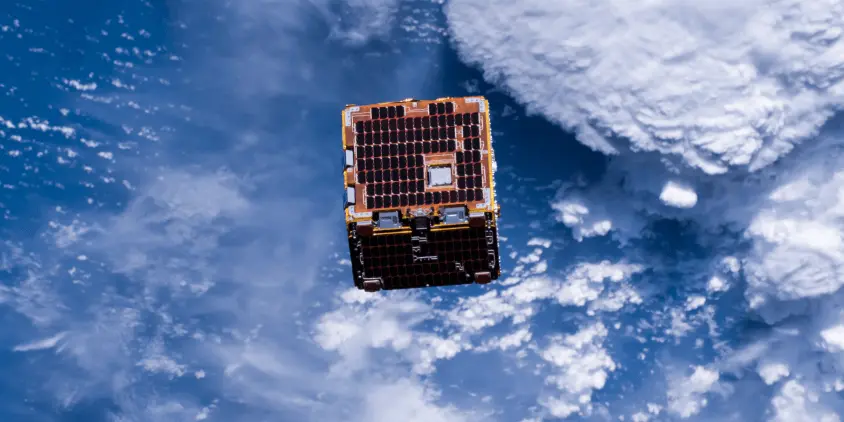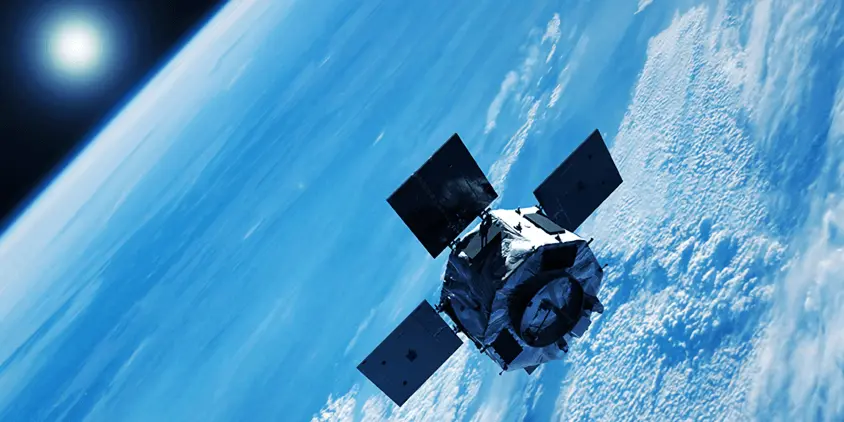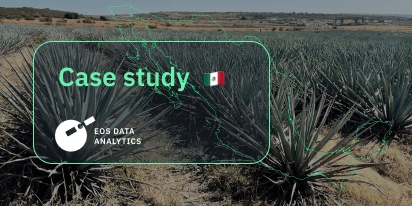
Small Satellites: Technology That Democratizes Space
In recent years, small satellites have opened up new possibilities for the space industry. Ranging from the size of a refrigerator to a shoebox, these nimble spacecraft are much smaller than traditional ones. This allows small satellites to leverage benefits like lower development and launch costs, rapid deployment, and operation in large constellations. Countless missions, including navigation, research, and remote sensing, rely on these compact devices. The shrinking of spacecraft has brought in numerous attractive scientific and business possibilities, and the space sector may already reap the benefits of this more sustainable and democratic approach.
What Are Small Satellites (Smallsats)?
When discussing spacecraft, the term “small” is typically used to describe their mass and size. In a nutshell, any satellite with a mass below 500 kg (1100 lb) is considered a small satellite, also called a smallsat, or a miniature satellite.
Satellites small in size are not new, though modern ones differ from their predecessors in many ways, the most notable of which is the use of widely accessible microelectronics in conjunction with innovative management approaches. This allows for the creation of spacecraft, working alone or in satellite constellations, that can carry out complex functions with great utility while consuming far less space, money, and time than previous generations.
Compared to the market for large-size spacecraft, the financial and technological barriers to entry into the smallsat market are typically much lower. Because of their tiny size, easier construction, and greater launch possibilities, these devices are affordable to many businesses and organizations.

Evolution Of Small Satellites
From their humble beginnings as experimental entities, smallsats have come a long way to become an independent type of satellites that is now indispensable to space operations. Recent developments in miniaturization, in-space propulsion, onboard processing and control, and communication systems have completely transformed the space sector by allowing smallsats to carry out complex tasks that were previously achievable only with larger spacecraft.
The Ionospheric Connection Explorer (ICON) is a superb illustration of the significance of small satellite technology. With its set of instruments, this spacecraft, weighing just 272 kg (600 pounds), successfully studies the ionosphere, the dynamic boundary between Earth’s and space’s weather. If not for ICON, two or more spacecraft in orbit would be needed to get the same view .
Types Of Small Satellites By Mass And Size
There is no universally accepted categorization for small-size satellites, and various factors are considered when classifying these spacecraft. These factors include mass, size, orbit, application, mission duration, and more. Nevertheless, the most prevalent classification is based on mass and size.
| Type | Mass (kg / lbs) | Maximum dimensions (m / ft) | Orbit |
|---|---|---|---|
| Minisatellite | 100–500 / 220–1100 | 3–10 / 10–33 | GEO, MEO, LEO, HEO |
| Microsatelliteo | 10–100 / 22–220 | 1–5 / 3–16 | LEO, HEO |
| Nanosatellite | 1–10 / 2.2–22 | 0.1–1 / 0.3–3 | LEO, HEO |
| Picosatellite | 0.1–1 / 0.22–2.2 | 0.05–0.1 / 0.16–0.3 | LEO, HEO |
| Femtosatellite | <0.1 / <0.22 | 0.01–0.1 / 0.03–0.3 | LEO, HEO |
Mini Satellites (Minisats)
Minisats typically weigh between 100 and 500 kg (220 and 1100 lb). Easily mass-produced for constellation-based systems, these small satellites are perfect for missions that prioritize cost-effectiveness. Common uses for minisats include commercial remote sensing constellations, messaging services (like Orbcomm), telecommunications constellations (like OneWeb and Starlink), and meteorology at low Earth orbit (LEO) and above.
Micro Satellites (Microsats)
The typical microsatellite weighs less than 100 kg (220 lb), including the propellant mass. Though they support real business uses, they may have limited capabilities in terms of pointing, longevity, etc. Scientific research and messaging are two examples of multi-satellite system applications that benefit from their high revisit rates and user availability.
Nano Satellites (Nanosats)
The typical mass threshold for a small satellite to be considered a nanosatellite is 10 kg (22 lb). Constructing nanosatellites according to CubeSat specifications opens up many launch options and guarantees continuous and cost-effective space access. These multi-unit CubeSats have a wide range of potential uses, such as scientific and educational experiments, communication systems like Sky and Space Global, and remote sensing networks like LANet.
Pico Satellites (Picosats)
Picosats weigh anywhere from 0.1 to 1 kg (0.22 to 2 lb). While they have a very limited capacity on their own, they can offer remarkable features in formation with multiple cooperating picosatellites, possibly teamed up with the mother spacecraft. One common use for these tiny satellites is data interchange over Internet networks with other devices.
Femto Satellites (Femtosats)
An invention of the last several decades, the femtosat makes use of cutting-edge nanotechnology to create an exceptionally miniature satellite that weighs under 100 grams (0.22 pounds). Many of these spacecraft have accompanied larger mother spacecraft as operational signal partners. Femtosats’ primary functions include image capture, testing of innovative technologies, biological experiments, and asteroid landings.
Benefits Of Small Satellites
Most advantages of small satellites stem from their miniature nature and include the following ones:
- Affordability. Small spacecraft have lower construction, launch, and operating costs, making remote sensing and space exploration more accessible to companies and organizations of all sizes.
- Shorter development cycle. Relatively short development and launch times for smallsats allow for faster deployment of space missions.
- Various uses. Miniature spacecraft have many potential uses and are adaptable to different missions.
- Constellations. Affordability and compact size make it feasible to launch constellations of smallsats for enhanced coverage and a broader range of applications.
- Reduced risks. In contrast to larger, more costly spacecraft that are subject to higher risk, small satellites can incorporate more recent technology that has not yet been space-tested due to the reduced overall cost risk.
- Single purpose. Unlike large multi-payload spacecraft, small ones that are purpose-built are simpler to operate and incorporate into a mission.

Challenges For Smallsat Industry
Small satellites have limited power budgets, payload capacities, and lifespans due to their miniature size. But smallsat engineers and designers are already coming up with creative ways to boost performance without increasing size. Additionally, due to power constraints, there is a push for the development of novel technologies such as innovative solar arrays, energy storage, and high-efficiency converters.
When it comes to synchronizing frequencies, avoiding collisions, and complying with international laws, smallsat service companies and constellation operators might confront regulatory hurdles. Space-related companies and organizations, such as the United Nations General Assembly and its Committee on the Peaceful Uses of Outer Space (COPUOS), all agree that it is vital to address these issues and leverage the opportunities given by small satellites . Improved regulations and advancements in technology, put in place to meet these problems, will pave the way for the ongoing success of miniature spacecraft in their missions of observing Earth, exploring space, and many more.
Real-World Applications Of Small Satellites
Compact spacecraft are better suited to certain uses than others since it is feasible to reduce the size of certain components, like digital processors and sensors, whereas there are constraints regarding other components. As an example, antenna aperture size restrictions limit the capabilities of smallsats in the telecommunications field. Conversely, due to the ease of downsizing the sensors, low-orbit constellations of small spacecraft are usually practical for different types of remote sensing. Small satellites are mostly employed in the following areas:
- Navigation. The navigational capabilities of low-Earth orbiting spacecraft equipped with global navigation space system (GNSS) receivers have been demonstrated to be accurate to within 10 meters.
- Earth observation. By capturing imagery and videos in high spatial resolution and transmitting them to Earth, smallsats in LEOs can easily handle environmental monitoring and asset tracking.
- Telecommunication. Small spacecraft are great for providing mobile services and Internet of Things (IoT) connectivity.
- Technology demonstration. To test the viability of new technology in orbit quickly and affordably, aerospace researchers employ small spacecraft.
- Scientific research. Astronomy, astrophysics, astrobiology, and space weather monitoring are just a few of the many areas of science facilitated by small satellites.
EOS SAT-1: Reshaping Farming With The Pioneering Multi-Purpose Small Satellite
EOS SAT-1, a multi-purpose optical small satellite for EO (Earth observation), focused on agriculture, forestry, natural disaster management, and urban monitoring, was built for EOS Data Analytics.

Low Earth orbit provides the spacecraft with constant lighting conditions, allowing it to consistently take high-quality images. EOS SAT-1 offers 11 spectral bands and high resolution, ensuring superior accuracy for agriculture applications. On top of that, our Mission Control solution allows for swift retargeting and downlinks to client sites upon request.
Designed to overcome current remote sensing limitations in areas such as spectral capacity and sensor resolution, the EOS SAT-1 small satellite offers the following advantages:
- Capturing minute details as if seen near, the panchromatic resolution of about 1.5 m enables change detection, precision mapping, and comprehensive agricultural image analysis.
- Combining “gold standard” satellite data with 44 times greater resolution multispectral data enhances the effectiveness of analysis.
- EOSDA’s continuous coverage of farmland for large-scale crop producers has an advantage over alternative systems in terms of the quantity and quality of regularly updated worldwide agricultural imagery.
- Hardware-level enhanced imaging ensures dependable data downlinks to any target area, regardless of weather conditions.
- Our powerful processing capabilities enable businesses of all sizes to easily and economically access ready-to-use data.
- Using specialized post-processing techniques, we can achieve an exceptional spatial resolution of 0.7m in panchromatic images.
The EOS SAT-1’s novel capabilities demanded confirmation that the data delivered by this small satellite aligns with other EO data and ground truth. The in-field confirmation of the EOS SAT-1’s data validity by comparing this data with actual ground measurements was accomplished on August 10 and 11, 2023. A strong correlation between ground measurements and space-derived data gives credibility to EOS SAT-1 for our customers.
EOSDA LandViewer
Search for AOI-specific satellite imagery, apply custom band combinations and download for free.
Trends And Innovations Defining The Future Of Small Satellites
A few trends can shed light on the potential near future of small satellite systems and services, so it’s worth keeping an eye on them. First and foremost, it is clear that artificial intelligence (AI) is making its way into space. Some examples of this include on-board data processing, automatic diagnoses based on telemetry, and the administration of constellations. In the future, AI has the potential to streamline and enhance all satellite-provided services and spacecraft control.
As space debris threatens operational spacecraft, more advanced de-orbiting systems and procedures are becoming the small satellite industry norm. In the current age of extensive space commercialization, it is more important than ever to set up reliable national and international standards for managing orbital debris, controlling space traffic, and improving space situational awareness. These measures might play a pivotal role in shaping the future of the small spacecraft sector.
No Small Step Toward Sustainable Space Technology
Small satellites are transforming the space industry as more economically viable and environmentally friendly alternatives and supplements for older space technologies. An example of a small satellite designed with sustainability in mind is the EOS SAT-1, with its energy efficiency and non-toxic components. Thanks to its enhanced resolution and agri-focused spectral bands, EOS SAT-1 is ideally suited for sustainability activities such as creating carbon sequestration models and aiding conservation initiatives. More innovations and sustainable practices are on the horizon as smallsats keep pushing the boundaries of space technology.
About the author:
Petro Kogut has a PhD in Physics and Mathematics and is the author of multiple scientific publications. He is the Soros Associated Professor as well as the head of the department of differential equations in the Oles Honchar Dnipro National University and has received a number of grants, prizes, honorary decorations, medals, and other awards. Prof. Dr. Petro Kogut is a science advisor for EOSDA.
Recent articles

Digital Tools Improve Soil Health And Yields In Mexico
EOSDA and ITTA supported a Guanajuato farm with contour-line planning, monitoring tools, and practical guidance to reduce soil erosion and improve yields in the long run.

Analyze 2025 & Plan Your Best Year Yet: LandViewer Christmas Offer
It’s the most wonderful time of the year! The Christmas holidays are here, and so is your chance to analyze 2025 and plan a prosperous 2026 with more affordable Pro plans in LandViewer.

EOSDA Models Climate Change Impact On Sugarcane Yields
EOSDA modeled future temperature, rainfall, and other climate impacts on Veracruz sugarcane. The results help growers plan long-term adaptation strategies, including timing, varieties, and irrigation.